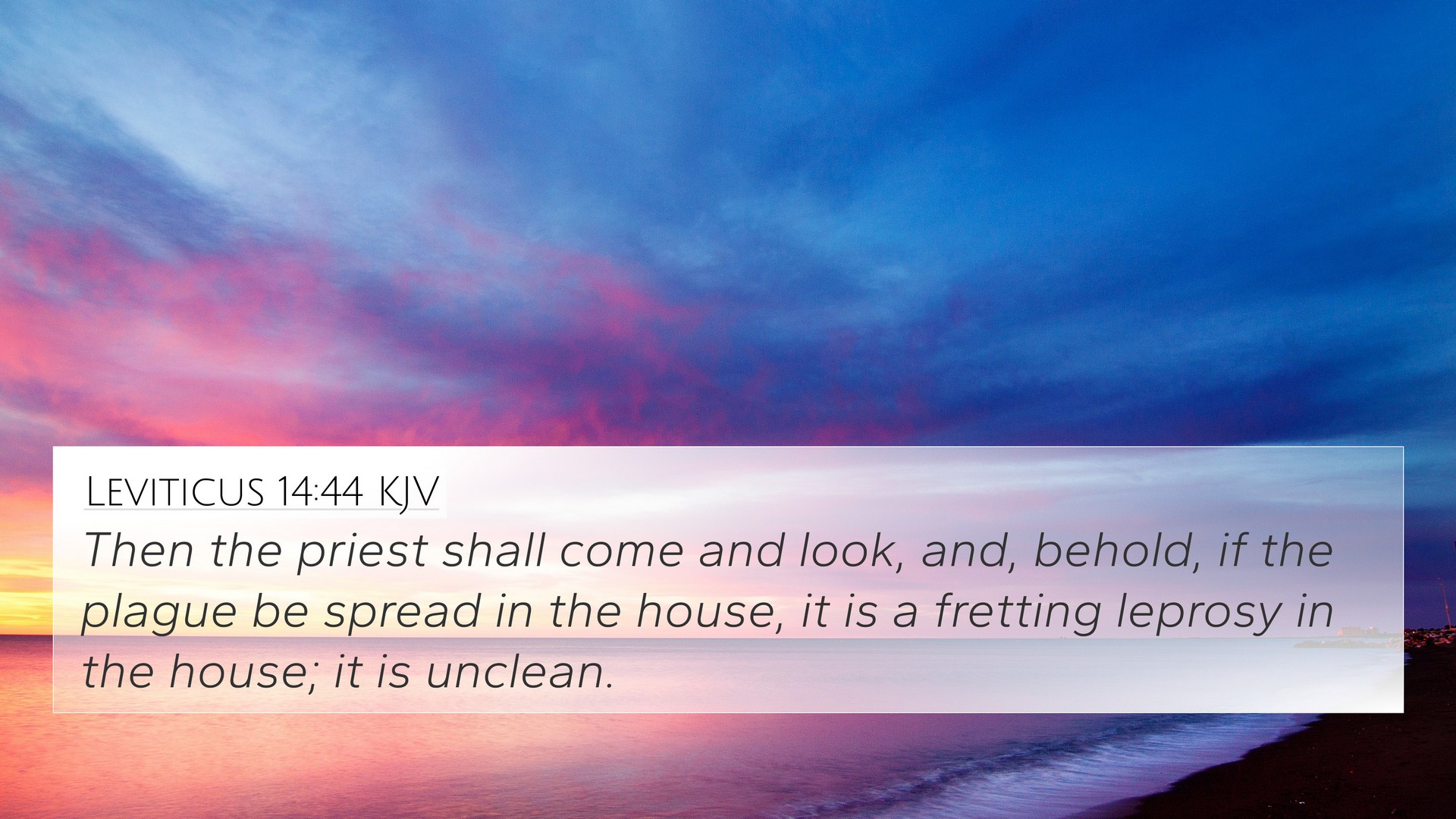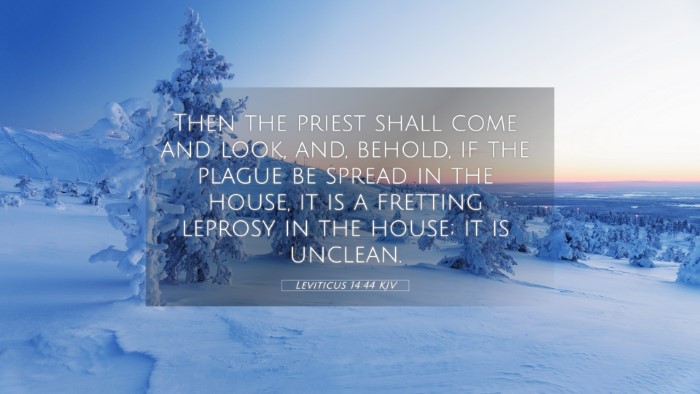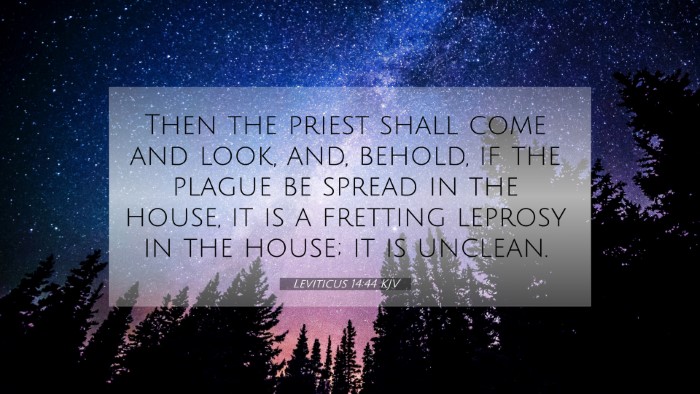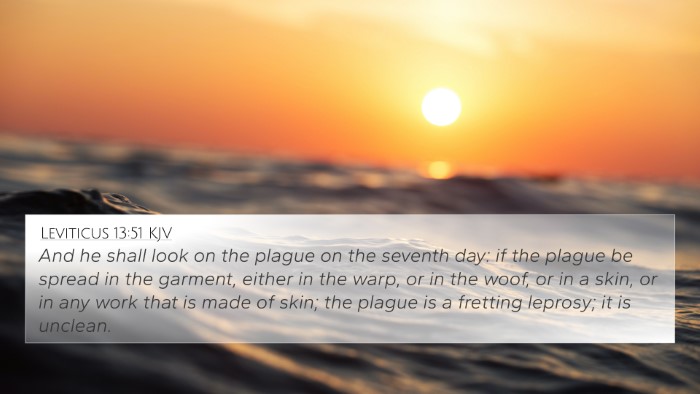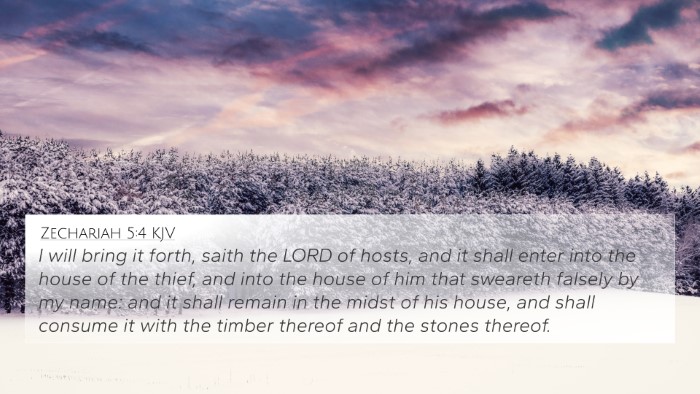Understanding Leviticus 14:44
The verse Leviticus 14:44 states, "And the priest shall come in and look: and, behold, if the plague be turned to white, then the priest shall pronounce him unclean: it is a dry scall." This verse is part of the laws regarding leprosy and indicates the procedures that priests must follow to determine the state of a person suffering from this affliction.
Summary of Leviticus 14:44 Meaning
This verse mandates a specific action from the priest when observing a suspected leprosy condition. Essentially, it highlights the importance of the priest's role in the community regarding health and purity, reflecting the holiness required in the presence of God.
Insights from Public Domain Commentaries
- Matthew Henry: Henry emphasizes the priest’s authority to make determinations regarding cleanliness and uncleanliness. The inspection of the plague is a serious matter; it signifies the need for spiritual and physical purity within the Israelite camp.
- Albert Barnes: Barnes discusses the implications of the "dry scall" as a symptom of uncleanliness before God. He connects this to the broader theme of how sin can manifest in various forms, and a careful inspection by spiritual leaders helps maintain community integrity.
- Adam Clarke: Clarke elaborates on the phrase “turned to white,” explaining that this signifies a change in condition that must be closely watched for the person’s restoration to health and community acceptance. It symbolizes grace and judgment intertwined, calling attention to the transformative layout of divine observation.
Cross-References and Thematic Connections
Leviticus 14:44 can be cross-referenced with several other verses in the Bible that deal with purity, leprosy, and the role of priests:
- Leviticus 13:2-3: Discusses how a priest should examine those suspected of leprosy.
- Numbers 5:2-3: Deals with the expulsion of unclean persons from the camp.
- Matthew 8:2-3: Jesus heals a leper, emphasizing the New Testament understanding of purity and healing.
- 1 Peter 2:9: Calls believers a 'royal priesthood,' drawing a parallel to the responsibilities of priests in Leviticus.
- Hebrews 7:27: Highlights the perfect priesthood of Christ compared to the Levitical priests.
- Isaiah 53:4: Foretells the suffering of Christ, who bore our infirmities and sorrows.
- Luke 17:12-14: The healing of ten lepers emphasizes the authority given to Christ and the role of the priest in declaring cleanliness.
Thematic Considerations
This verse and its commentary reveal significant themes regarding:
- Purity: The need for spiritual cleanliness in the presence of God.
- Authority: The critical function of priests as mediators in the community regarding health matters.
- Transformation: The hopeful turnaround from unclean to clean, symbolizing God's grace in both the Old and New Testaments.
Tools for Further Study
For those interested in deeper study of this verse and its connections, consider utilizing the following:
- Bible Concordance: A resource to find specific terms and their occurrences in the Scriptures.
- Bible Cross-Reference Guide: Helps to find related verses that share thematic or contextual links.
- Cross-reference Bible Study Methods: Techniques to analyze and understand the relationships between various scriptures.
Conclusion
Leviticus 14:44 serves as a crucial reminder of both the importance of maintaining spiritual and physical cleanliness in the community and the vital role of spiritual leaders in that process. The interconnectedness of scripture illustrates the continuity of God's message regarding purity and healing throughout the Bible.
